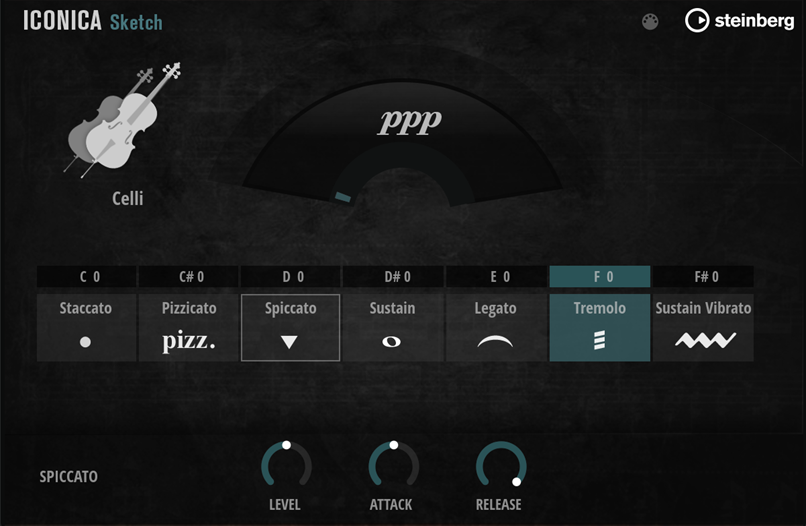Parameters
In the parameter section at the bottom of the panel, you can set up the parameters for the articulations. The range of available parameters depends on the type of articulation.
Adaptive True Legato
Iconica Sketch uses an Adaptive True Legato system that employs recorded legato transitions for playing realistic connected lines. The legato reacts to the playing speed: in a slow line, the full length of the legato transitions is played. When playing fast, transitions are shortened, for a tighter and more agile playing style. Adaptive True Legato is focused on providing smooth connected lines, preserving the note boundaries. It does not employ portamento or similar slides between notes.
Key Switches
In programs, every articulation button is assigned to a key switch. You can select a different key switch by double-clicking the note name and entering a new value, or by clicking the note name and dragging up/down. While you can only assign an articulation button to a single key switch, you can assign a key switch to multiple articulation buttons, which allows you to stack articulations. On pressing a key switch, the corresponding articulation is activated, and its articulation button lights up.
Articulation Parameters
The parameter section at the bottom of the panel shows the parameters for the selected articulation. The available parameters differ for the individual articulations.
The selected articulation is not necessarily the articulation that is currently playing. You can identify the selected articulation by its white outline. The articulation button of the articulation that is playing changes color.

- Level
-
Sets the volume of the articulation. By default, the articulations are pre-balanced.
- Attack
-
Determines the duration of the attack. The lower the values, the later the sample start, and the tighter the playing style – at the expense of the attack characteristics.
Note-
In legato articulations, the Attack parameter influences the attack of the first note in a sequence; all connected notes remain unaffected.
-
For percussion instruments, the attack can only be lengthened, not shortened.
-
- Release
-
Controls the length of the release.
If True Release is activated, the release sample is affected. If True Release is deactivated or no dedicated release samples are available, Release controls the fade-out time of the sample.
- True Release
-
Allows you to make settings for the use of True Release samples.
For legato articulations, the following options are available:
-
Legato+Release – True Release samples are always played, both for single notes and for notes within a connected legato sequence.
-
Legato – As long as connected legato notes are played, True Release samples are played. The last note in a legato sequence can be freely adjusted and/or extended in its release.
-
Off – True Release samples are off.
Other articulations that support True Release feature a checkbox that allows you to activate/deactivate the use of True Release samples.
NoteIf True Release is activated, the release tail can only be shortened, not lengthened, because the natural release tail is the upper limit of the release time.
-
- Stop Key
-
The Glockenspiel, Harp, Timpani, and Tubular Bells instruments feature a Stop Key parameter.
Usually, these instruments resonate for a long time. Pressing the assigned Stop Key dampens playback for all sounding notes, allowing you to make them end more quickly without being too abrupt. If the Stop Key is not pressed, the sound of the instrument decays naturally.